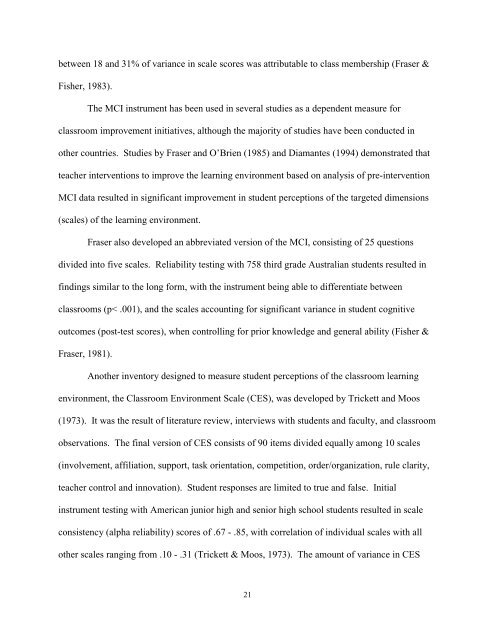STUDENT EVALUATION OF CLINICAL EDUCATION ENVIRONMENT
STUDENT EVALUATION OF CLINICAL EDUCATION ENVIRONMENT
STUDENT EVALUATION OF CLINICAL EDUCATION ENVIRONMENT
You also want an ePaper? Increase the reach of your titles
YUMPU automatically turns print PDFs into web optimized ePapers that Google loves.
etween 18 and 31% of variance in scale scores was attributable to class membership (Fraser &<br />
Fisher, 1983).<br />
The MCI instrument has been used in several studies as a dependent measure for<br />
classroom improvement initiatives, although the majority of studies have been conducted in<br />
other countries. Studies by Fraser and O’Brien (1985) and Diamantes (1994) demonstrated that<br />
teacher interventions to improve the learning environment based on analysis of pre-intervention<br />
MCI data resulted in significant improvement in student perceptions of the targeted dimensions<br />
(scales) of the learning environment.<br />
Fraser also developed an abbreviated version of the MCI, consisting of 25 questions<br />
divided into five scales. Reliability testing with 758 third grade Australian students resulted in<br />
findings similar to the long form, with the instrument being able to differentiate between<br />
classrooms (p< .001), and the scales accounting for significant variance in student cognitive<br />
outcomes (post-test scores), when controlling for prior knowledge and general ability (Fisher &<br />
Fraser, 1981).<br />
Another inventory designed to measure student perceptions of the classroom learning<br />
environment, the Classroom Environment Scale (CES), was developed by Trickett and Moos<br />
(1973). It was the result of literature review, interviews with students and faculty, and classroom<br />
observations. The final version of CES consists of 90 items divided equally among 10 scales<br />
(involvement, affiliation, support, task orientation, competition, order/organization, rule clarity,<br />
teacher control and innovation). Student responses are limited to true and false. Initial<br />
instrument testing with American junior high and senior high school students resulted in scale<br />
consistency (alpha reliability) scores of .67 - .85, with correlation of individual scales with all<br />
other scales ranging from .10 - .31 (Trickett & Moos, 1973). The amount of variance in CES<br />
21












